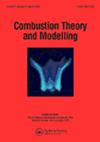内旋小火焰模型
IF 1.6
4区 工程技术
Q4 ENERGY & FUELS
引用次数: 2
摘要
提出了一种新的旋转小火焰模型,该模型具有通过拉伸涡流管的向内旋流,用于子网格建模,以与湍流燃烧的解析流相结合。与现有模型相比,该模型具有关键的新功能。(i) 非预混火焰、预混火焰或多分支火焰结构是确定的,而不是规定的。(ii)确定了涡度和相关离心加速度的影响。(iii)在子网格级应用的应变速率和涡度可以直接从解析的尺度应变速率或涡度中确定,而无需人为的进度变量。(iv)小火焰模型是三维的。(v) 讨论了可变密度的影响。(vi)向内涡流是由涡度与两个压缩法向应变分量相结合产生的;这一特点将该模型与逆流小火焰模型区分开来。获得了控制小火焰模型的多分量Navier-Stokes方程的解。通过坐标变换,通过一个常微分方程组,找到了该模型的类似解。涡流在子网格逆流上产生离心力,从而改变分子传输速率、燃烧速率和可燃极限。给出了不与解析流耦合的内旋旋转小火焰模型的示例计算,以证明新特征的重要性。研究了预混合、非预混合和多分支火焰结构。用正应变率、涡度、Damköhler数和Prandtl数进行了参数测量。当离心效应与可变密度场相结合时,会产生有趣的结果。流动方向可以反转;燃烧速率可以被修改;可燃性极限可以延长。本文章由计算机程序翻译,如有差异,请以英文原文为准。
Inward swirling flamelet model
A new rotational flamelet model with inward swirling flow through a stretched vortex tube is developed for sub-grid modelling to be coupled with the resolved flow for turbulent combustion. The model has critical new features compared to existing models. (i) Non-premixed flames, premixed flames, or multi-branched flame structures are determined rather than prescribed. (ii) The effects of vorticity and the related centrifugal acceleration are determined. (iii) The strain rates and vorticity applied at the sub-grid level can be directly determined from the resolved-scale strain rates and vorticity without a contrived progress variable. (iv) The flamelet model is three-dimensional. (v) The effect of variable density is addressed. (vi) The inward swirl is created by vorticity combined with two compressive normal strain components; this feature distinguishes the model from counterflow flamelet models. Solutions to the multicomponent Navier–Stokes equations governing the flamelet model are obtained. By coordinate transformation, a similar solution is found for the model, through a system of ordinary differential equations. Vorticity creates a centrifugal force on the sub-grid counterflow that modifies the molecular transport rates, burning rates, and flammability limits. Sample computations of the inward swirling rotational flamelet model without coupling to the resolved flow are presented to demonstrate the importance of the new features. Premixed, nonpremixed, and multi-branched flame structures are examined. Parameter surveys are made with rate of normal strain, vorticity, Damköhler number, and Prandtl number. The centrifugal effect has interesting consequences when combined with the variable-density field. Flow direction can reverse; burning rates can be modified; flammability limits can be extended.
求助全文
通过发布文献求助,成功后即可免费获取论文全文。
去求助
来源期刊

Combustion Theory and Modelling
工程技术-工程:化工
CiteScore
3.00
自引率
7.70%
发文量
38
审稿时长
6 months
期刊介绍:
Combustion Theory and Modelling is a leading international journal devoted to the application of mathematical modelling, numerical simulation and experimental techniques to the study of combustion. Articles can cover a wide range of topics, such as: premixed laminar flames, laminar diffusion flames, turbulent combustion, fires, chemical kinetics, pollutant formation, microgravity, materials synthesis, chemical vapour deposition, catalysis, droplet and spray combustion, detonation dynamics, thermal explosions, ignition, energetic materials and propellants, burners and engine combustion. A diverse spectrum of mathematical methods may also be used, including large scale numerical simulation, hybrid computational schemes, front tracking, adaptive mesh refinement, optimized parallel computation, asymptotic methods and singular perturbation techniques, bifurcation theory, optimization methods, dynamical systems theory, cellular automata and discrete methods and probabilistic and statistical methods. Experimental studies that employ intrusive or nonintrusive diagnostics and are published in the Journal should be closely related to theoretical issues, by highlighting fundamental theoretical questions or by providing a sound basis for comparison with theory.
 求助内容:
求助内容: 应助结果提醒方式:
应助结果提醒方式:


